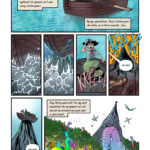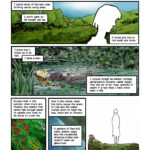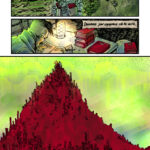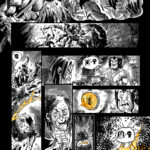About Emma Newman
Emma Newman writes short stories, novels and novellas in multiple speculative fiction genres. She is a professional audiobook narrator, and a Hugo Award winning podcaster. Her current podcasts are ‘Imagining Tomorrow’ and ‘Tea and Sanctuary’. www.enewman.co.uk
The Script
Comic script - this is exactly what happened to my son in the small hours of this morning. I only saw the messages when I woke up, and he told me what happened once he was awake. It made me laugh, and I immediately thought it might make a fun comic and Beanie agreed!
A young man (if you want to base him loosely on my son, he’s 16 years old, tall, short brown hair, blue eyes) is about to leave his room but spots a huge spider on wall next to the door (it is on the wall that the door would rest against when open and the dressing gown hanging on the back of the door would brush against where the spider is) .
He is terrified of spiders, so he can’t open the door. It’s the small hours of the morning.
He leaps onto his bed on the other side of the room, a bookcase blocking the line of sight between him and the spider and tries to phone his Mum who is sleeping in her room across the landing, and message her on WhatsApp, but her phone is on ‘Do not disturb’ so there’s no answer.
Panicking, he phones friends until one finally picks up - ‘Help! There’s a huge spider in my room!’
Friend: What colour is it?
Beanie: Black? Brown? I dunno! It was BIG
Friend: You’re okay, I don’t think they can climb.
Beanie: IT’S ON MY WALL! (throughout the rest of this exchange the friend also now freaking out is just making Bean panic even more!)
Friend: Oh, that one can climb then! Just dash out the door!
Beanie: It’s by the door, I can’t get out!
Friend: IT’S IN YOUR ROOM?!
Beanie: Yes, I told you this!
He peeps round the bookcase. The spider is gone!
Beanie: It’s gone!
Friend: THAT MEANS IT COULD BE ANYWHERE!
Beanie’s eyes flick to all the posters it could be hiding behind, and all the clothes and stuff on his floor it could now be lurking under.
Beanie: YOU ARE NOT HELPING!
He hangs up and hides in the duvet. If you think that a final shot on the spider’s hiding place would be a good ending, do add that in, but happy to end it on Beanie hiding.
Artists Notes
One of the goals of the project was to try and work with as many writers as possible, and so I told every writer "Don't worry - I'll take any format of script" - there are sort of comic script standards, and attempts have been made in the past to really hammer them in, but for the most part every writer I work with works a little different anyway. That said, this script required a lot of thinking about to get the most out of the story (you can argue amongst yourself whether that's what I did).
Firstly there's a sort of action limit in comics, every action will usually require one panel - character opens door, walks through door, locks door? that's three panels. I felt like, on this script, there was too much going on to fit in the super limited single page I had, plus some of the action I wanted to build it up a bit more, so I knew I'd be putting a bunch of panels towards the getting ready to go out (because build up build up build up build up PUNCHLINE!) I also knew I wanted the dialogue interaction to have that ratatatat rapid delivery, which meant I'd get a single panel for that set of dialogue. This meant brutalising the story a little, cutting out the contacting of his mum and going straight to the friend. I also wanted a little end note on the spider - I thought that would be fun, a happy little chappy. (remove the last spider panel and the page feels like it's not quite finished - it's a figurative and literal full stop)
The manga shading effect/speedlines came after I'd drawn it and realise it would work better with a little bit of manga (tonally too, fits a teen), and the coloured lettering was because I needed someway to quickly distinguish the two sets of dialogue (I decided to eschew clip studio's balloon lettering tools a) because it would take ages to get exactly how I want it and b) because I thought I could add more character to it that way. The background of the room is pretty much a direct tracing of my teenage son's bedroom (which is so quintessentially teenager it looks like a set from a modern John Hughes teen comedy). (And it's all my son's work, he's done that all without parental help)
Anyway. This was finished the day before publication, but I think it turned out ok.
Oh, and because I drew it, and then slathered lettering all over it, here's the page without dialogue...










 Unlock with Patreon
Unlock with Patreon
Recent Comments